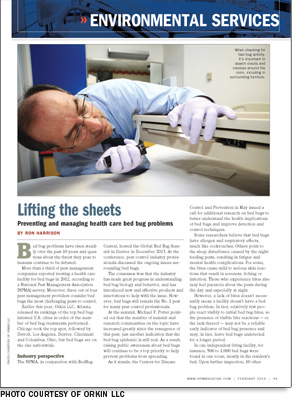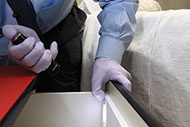 Bed bug problems have risen steadily over the past 10 years and questions about the threat they pose to humans continue to be debated.
Bed bug problems have risen steadily over the past 10 years and questions about the threat they pose to humans continue to be debated.
More than a third of pest management companies reported treating a health care facility for bed bugs in 2012, according to a National Pest Management Association (NPMA) survey. Moreover, three out of four pest management providers consider bed bugs the most challenging pests to control.
Earlier this year, Orkin LLC, Atlanta, released its rankings of the top bed bug-infested U.S. cities in order of the number of bed bug treatments performed. Chicago took the top spot, followed by Detroit, Los Angeles, Denver, Cincinnati and Columbus, Ohio, but bed bugs are on the rise nationwide.
Industry perspective
The NPMA, in conjunction with BedBug Central, hosted the Global Bed Bug Summit in Denver in December 2013. At the conference, pest control industry professionals discussed the ongoing issues surrounding bed bugs.
The consensus was that the industry has made great progress in understanding bed bug biology and behavior, and has introduced new and effective products and innovations to help with the issue. However, bed bugs still remain the No. 1 pest for many pest control professionals.
At the summit, Michael F. Potter pointed out that the number of summit and research communities on the topic have increased greatly since the resurgence of this pest, just another indication that the bed bug epidemic is still real. As a result, raising public awareness about bed bugs will continue to be a top priority to help prevent problems from spreading.
As it stands, the Centers for Disease Control and Prevention in May issued a call for additional research on bed bugs to better understand the health implications of bed bugs and improve detection and control techniques.
Some researchers believe that bed bugs have allergen and respiratory effects, much like cockroaches. Others point to the sleep disturbance caused by the night-feeding pests, resulting in fatigue and mental health complications. For some, the bites cause mild to serious skin reactions that result in soreness, itching or infection. Those who experience bites also may feel paranoia about the pests during the day and especially at night.
However, a lack of bites doesn't necessarily mean a facility doesn't have a bed bug problem. In fact, relatively few people react visibly to initial bed bug bites, so the presence of visible bite reactions — or the lack thereof — may not be a reliable early indicator of bed bug presence and may, in fact, leave bed bugs undetected for a longer period.
In one independent living facility, for instance, 500 to 1,000 bed bugs were found in one room, mostly in the resident's bed. Upon further inspection, 10 other separate cases of bed bugs were found in the same facility. However, no bite reactions were reported by the facility's residents in the other affected areas. This finding was correlated by research at the University of Kentucky that showed that the elderly have a diminished response to skin irritants and are less likely to exhibit a reaction than younger people.
Beyond the potential health implications, bed bugs should be a business concern for health care and long-term care facilities. As unwanted pests, the presence of bed bugs is a disturbance to patients and residents.
When bed bugs are present, they can evoke the impression that infested facilities are unsanitary. With peace of mind and reputations at stake, attention should be given to developing prevention and treatment strategies.
Preventive measures
Prevention has patient rights and provider responsibility implications that should be weighed carefully. Aggressive policies to control incoming materials or searches of incoming personal items may raise privacy concerns and anxieties.
Particularly for long-term care providers, this could create a discomforting atmosphere for incoming residents who may already be stressed by a transition from independence to facility living. Measures that are effective without alarming residents include:
Checking mattresses. Conduct a visual inspection for evidence of bed bugs in bedding as it is brought in.
Requiring encased mattresses and box springs. An inexpensive synthetic covering on mattresses and especially box springs prevents bed bugs from reaching the fibrous interior or hiding along edges or under tags. For pests that already have found harborage, the encasement prevents their escape and access to food sources.
Inspecting incoming furniture. Much like bedding, sofas, plush chairs and other furniture easily can harbor bed bugs.
Utilizing monitoring technology. Equipment that uses carbon dioxide, heat and a kairomone can lure bed bugs out of hiding within two hours. There also are bed bug pitfall traps that can be helpful in monitoring. This technology is available through some pest management professionals.
Bed bug-sniffing dogs. Trained canine teams are among the most effective detectors of the presence of bed bugs, and many pest management companies now are utilizing them to identify problems.
DNA testing. Some trained and certified bed bug specialists can inspect key areas suspected of bed bug activity and within 48 hours, a DNA swab sample can determine their presence.
Hospitals and acute care facilities typically are less conducive environments for bed bugs. Unlike nursing home residents, who stay in one place for extended periods, health care patients enter, undergo treatment and are released. In addition, most clinical beds have metal frames and plastic-covered mattresses, denying bed bugs a porous harborage. Finally, as patients come and go, the stringent cleaning practices that prevent cross-contamination also create a hostile environment for pests and can keep bed bugs in one room from making their way to another.
However, there are areas in health care facilities that are more at risk of bed bugs. Overnight guests in maternity, long-term care and hospice are more likely to bring luggage and other personal effects. These areas should be more closely monitored during routine cleaning to ensure that bed bugs did not make their way into the facility in someone's luggage. Psychiatric wards where patients are admitted as temporary residents are another hot spot for bed bug activity.
A quarterly inspection will help to identify pests that have found harborage in the furniture or elsewhere in the room.
Monitoring activity
Monitoring and early detection are crucial to preventing bed bugs from taking hold and causing an infestation. A pest management professional can educate facilities staff on the importance of the problem and train them to recognize the signs of bed bugs.
As nocturnal pests, bed bugs typically hide during the day, but evidence of their nightly wandering can be found on mattress edges and tags. Small, dark brown-colored stains in these areas may be signs of bed bugs.
In long-term care facilities or long-term care hospital units, integrating bed bug monitoring into regular cleaning routines can help to identify problems before they spread. A sample inspection schedule might include:
• Weekly monitoring for evidence when changing the sheets, including checking the mattress cover and the edges of the mattress.
• Monthly inspections of box springs for similar signs.
• Quarterly inspections of potential harborage locations, including behind pictures and headboards and in sofas, plush chairs or other furniture.
Treatment regimens
If routine monitoring uncovers a bed bug problem, the health facility's pest management professional should be contacted immediately. Remediation tactics will be less invasive if initiated in the early stages of an infestation. Nonchemical remediation methods include:
Disposal. If furniture or other items harboring bed bugs can be disposed of, it increases the chances of a successful eradication.
Laundering. Items that can be laundered should be washed in hot water with detergent and placed in a dryer. The high temperatures of the dryer will kill bed bugs at all stages.
Heat treating. Pest management professionals can use special equipment to heat the room or the room's belongings to the necessary temperature for a sustained period to eradicate any bed bugs. Dry steam can be used on carpets, mattress edges and cushioned furniture.
A widespread infestation affecting multiple locations within the facility will require a more aggressive approach involving chemical treatments. Chemical treatments should only be applied by a licensed, trained pest management professional. More aggressive remediation measures include:
Fumigating. A chemical material will kill all pests and leave no residual. However, it requires the health care facility to be completely cleared, which can be a challenge.
Non-residual chemical treatments. Alcohol-based, non-residual products can be used to kill bed bugs on contact.
Residual chemical treatments. Chemically treating carpet edges, baseboards, furniture, headboards and other hiding places is another measure.
Treating for bed bugs presents challenges. The pests can be resistant to chemicals. They also may be repelled by chemicals and be driven to seek harborage elsewhere in the facility after treatment. Sensitivity to the use of chemicals in a health care facility also is a concern and should be discussed with a pest management professional.
Insect growth regulators (IGRs), which use synthetic pest hormones to prevent pests from reaching maturity, have been effective in the treatment of other types of pests, but appear to be less successful with bed bugs. There have been no studies that indicate IGRs are effective in the field.
Education and cooperation
Working with a pest management professional, staff education and cooperation are essential to identifying and reporting potential bed bug infestations.
Pest management professionals can educate employees about the pests, harborage points and signs of their presence.
They also can train staff on sanitation practices and monitoring activities that will reduce the risk of an infestation and help to ensure that any bugs that enter the facility won't take up residence.
Ron Harrison is an entomologist and director of technical services for Orkin LLC, Atlanta, and an acknowledged leader in the field of pest management. He can be contacted at rharriso@orkin.com.
For more information
This article was based on updated information from a joint white paper published by Orkin LLC, Atlanta, and the Association for the Healthcare Environment. To download a copy of the full document, go to www.ahe.org/ahe/content/orkin/ahe-bedbug-white-paper.pdf.




